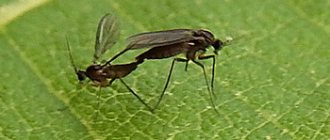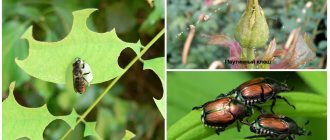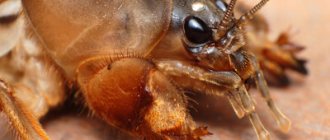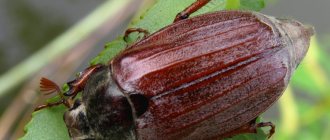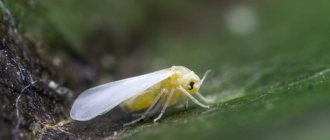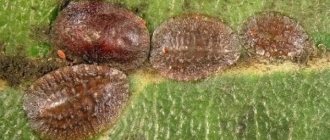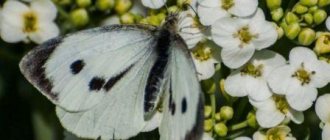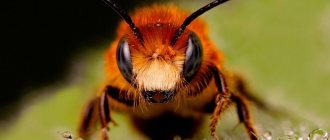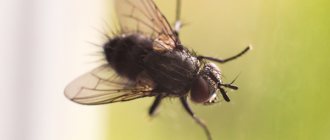Home flowers create a cozy atmosphere, make the air cleaner, and make us happier. But sometimes all the joy is overshadowed by such a nuisance as the appearance of midges or, more precisely, sciarids. They can attack any houseplant, but Saintpaulias (violets) are especially affected.
Sciarids (lat. Sciaridae), also known as fungus gnats , are small insects from the order Diptera (lat. Diptera). The first representatives of sciarids appeared many millions of years ago; now these insects are considered one of the most ancient living organisms that have survived in our time. Currently, about one and a half thousand different species belonging to thirty genera have a scientific description. And about twenty thousand more species have not yet been thoroughly studied. Naturally, all these types of sciarids differ from each other in size, color, and so on. But these differences are practically invisible to the human eye and are visible only under a microscope.
For domestic plants in the middle zone, three types of sciarids are mainly dangerous: Bradysia, Sciara, Lycoriella. They are all very similar to each other.
In general, adult fungus gnats are small flies, 3-4 mm long, usually black or dark gray in color. Young sciarids are mosquitoes about 2 mm in size, and the larvae are white worms with a black head.
The peak of fungus gnat reproduction usually occurs in the cold season, when plants are watered less frequently, but the soil dries out more slowly. The earth becomes too acidic, which leads to the proliferation of insects, just like watering a flower with tea leaves, creating a nutrient medium for them.
The main harm to the plant is caused not by the midges themselves, but by their larvae, which develop in moist, acidic soil and feed on the tender tips of the roots, thereby undermining the basic vitality of the plant. A plant with an affected root system usually becomes sick, withers, does not bloom, and may eventually die. The damage caused by adult sciarids cannot be called devastating. The owners are mainly upset that insects spoil the appearance of the plant with their presence. However, if the number of midges increases significantly, they begin to feed on the above-ground parts of the plant, preferring tender young shoots.
To understand how to get rid of midges in indoor flowers permanently, you need to know the channels of their penetration. Fungus gnats enter the room from the outside, for example, through hoods, or with a bouquet brought from the forest. Rooms with warm and humid climates are especially suitable for them. Another popular habitat for sciarids is food waste, such as rotten fruits or vegetables.
But still, most often fungus gnats are introduced with newly acquired potted plants, so you should take it as a rule:
[!] Each new flower must undergo a two-week quarantine!
Quarantine involves a thorough inspection of the new plant, including, if possible, the root system, then the plant must be washed and treated with phytoverm.
If, nevertheless, uninvited guests have settled in a flower pot, how can you get rid of them with minimal losses and without harming the plant?
Description and appearance
Experts identify about 1.5 thousand species of this insect. But gardeners at home most often encounter only one of them, namely sciaridae .
Fungus gnat
The size of an adult insect is 3-4 mm. The fungus gnat has a narrow, elongated body and a rounded head. The color of the insect is gray or black. In the thoracic region there are three pairs of thin paws. In the frontal part there are elongated whiskers that help the insect navigate in space. The fungus gnat has one pair of transparent wings. Adults do not feed; their main function is to breed offspring.
Fungus gnat
Sciarid larvae
The larvae of the fungus gnat are worm-shaped and legless. Their body length at birth does not exceed 2 mm, and during development it reaches 10 mm. The larvae have a dark head and a transparent light body color, through which the intestines are visible. The mouthparts are gnawing type. Large larvae are capable of leaving a slimy trail on the soil surface as they move.
Sciarid larva
What is an insect
The fungus gnat, a photo of which is shown in the figure below, is also called sciara fly.
Belongs to the order Diptera, family Sciaridae. The mosquito is a small insect with a narrow oblong body 1.5-4 mm in size. The color is black and gray. Moreover, the color of the body becomes darker as the individual “gets older.” The head is rounded with long antennae. Mouthparts are sucking. The wings are only the front ones, they are transparent. But they fly well. The hind pair of wings are transformed into club-shaped halteres. Due to this, a characteristic sound can be heard during flight. Adults do not harm plants. They do not bite or suck blood. They don't get into your eyes. But they can be carriers of various fungal diseases that harm both plants and people.
Life expectancy is approximately a week. But during this time the insect manages to lay up to 300 eggs. The female lays eggs on the surface of moist soil or in the soil between the roots. A few days later, larvae emerge from the eggs. They have no legs and resemble worms.
Fungus gnat larvae are transparent, with a clearly visible intestine and a black “head”. It is the “head” that is the distinctive feature by which sciarids are distinguished from other types of larvae. The length of the larva reaches 8-10 mm. Their mouthparts are gnawing. They feed on plant remains that decompose in the soil. In flower pots when food is scarce, they eat plant roots and young shoots in the soil. This causes irreparable harm to plants. A few days later, pupation occurs and a young midge appears. The remaining shells decompose in the ground. The larvae do not like dry soil. If they are taken out of damp soil into the air, they quickly die.
Sciarids are often confused with Drosophila. If the former have a “slender” body, then the latter are thicker. The mosquito has a head and chest larger than the rest of the body, and a thin abdomen. And Drosophila has no differences between the chest and abdomen.
Reproduction and development stages
Female sciarids lay eggs on the surface of moist soil or directly into the soil near the roots of the plant. After 5-7 days, larvae emerge from them. They begin to actively feed, which determines their accelerated pace of development. The sciarid remains in the larval stage for 2 weeks. At the last stage of development, they become inactive, and their appetite decreases. After this, the sciarid larvae pupate.
After 3-4 days, adults emerge from them. And after a day, new adult sciarids are ready to independently breed offspring, and the cycle resumes. The lifespan of females is 3-4 weeks. During this period, the sciarid lays from 50 to 300 eggs. Optimal conditions for reproduction: temperature +240C and humidity level 75-100%.
Preventive measures
Preventive measures must be followed to prevent pests such as sciarids from infesting your indoor flowers. The following will prevent the appearance of the insects we are studying.
- The soil that you have prepared for planting or replanting a houseplant should be clean, free from residues and rot.
- Before pouring the soil into the pot, treat it with potassium permanganate and sprinkle with charcoal.
- You need to wash the pot with hot water before using it, and also disinfect it with the same potassium permanganate.
- Coarse sand, ceramic fragments, expanded clay, and gravel will provide drainage. Sprinkle it over the top layer of soil.
- Don't go overboard with organic fertilizers: add moderate amounts of compost and manure to the soil.
- Coffee grounds, tea leaves, and dairy products such as kefir and milk do not make good fertilizers.
- Houseplants should be watered exclusively with clean water.
- If there is excess water left in the flower tray after watering, it should be poured out.
- Plants should not be watered frequently. Only after the top layer of soil has dried can the watering procedure be repeated.
- Rotting remains of indoor flowers need to be disposed of in a timely manner.
If you comply with the above conditions, flower gnats will not appear in your plants at home.
Why is it dangerous?
Sciarid flies do not pose any danger to plants. The main damage to crops is caused by the larvae of the pest. As a result of their vital activity, metabolic processes in the root system of the plant are disrupted.
Pests
It causes:
- dejected general appearance;
- decreased immunity;
- slow growth;
- loss of turgor in leaves;
- shedding of buds and flowers.
In the absence of timely control measures, the weakened plant does not develop and dies.
Symptoms of the presence of midges in orchids
Insects are not difficult to see; above a pot with an orchid, a swarm of black midges is clearly visible, and on the leaves and fragments of the substrate they are noticeable with the naked eye.
However, you can only determine whether they are harmful by removing the plant from the pot. We invite you to familiarize yourself with Growing peanuts in the country and at home
The orchid, one way or another, will have to be replanted, because the very fact of the appearance of a large number of midges already tells the gardener that not all is well with the substrate. Therefore, it is necessary to make sure that everything is in order with the orchid’s root system and replant it in a fresh soil mixture that excludes mold fungi and green algae deposits.
During transplantation, the roots are carefully inspected, washed in a weak solution of potassium permanganate, and the wounds, if any, are sprinkled with activated carbon powder or cinnamon to prevent bacterial or fungal infections from entering them. The transplanted plants are kept more dry than usual for 4–7 days.
Methods for killing fungus gnats
The appearance of small midges in an apartment should not go unnoticed by the gardener. Pest control must be comprehensive, using different methods.
Mechanical methods of struggle
- Sciarid larvae die in a dry environment, so when they appear in a pot, you must first loosen the soil to reduce the humidity level. This will reduce the number of pests.
- In the future, it is necessary to replace the top layer of soil in the pot with a new one and add river sand to it in a ratio of 1:2. This component does not retain moisture, which will slow down the process of reproduction of offspring.
- Additionally, next to the infected flowers, you should hang or place adhesive tape, preferably yellow, since this is the shade that attracts the attention of midges.
- Throughout the entire period of combating fungus gnats, it is necessary to limit watering of plants to a minimum, and moisten the soil only as the top layer dries.
river sand
Folk wrestling recipes
With a small number of pests, you can fight sciarids using folk remedies. They should be prepared based on available ingredients that can be found in every home.
Effective ways to get rid of fungus gnats:
- Garlic . Grind 5-6 cloves, pour warm water over them. Leave the mixture for a day. Water the infected plants with the resulting solution. Repeat the procedure three times every 5 days.
- Shag . Pour 40 g of the component into 1 liter of boiling water, cover with a lid and keep in this form for 2 days. After the waiting period has expired, strain the mixture and add 2 liters of settled water. Water the plant at least 4 times every 4 days.
- Laundry soap. Grate 40 g of the component and pour in 1 liter of warm water, mix thoroughly until a homogeneous composition is obtained. Spray the top layer of soil in the pot with the product. Repeat the procedure three times, once every 5 days.
Insecticides
When mass reproduction of sciarids occurs, it is necessary to use chemicals to treat infected plants.
The following insecticides will help solve the problem:
- Aktellik;
- Inta-vir;
- Fitoverm;
- Kinminx.
To process, you need to prepare a solution in the proportion specified in the instructions and spray it on the top layer of soil. You should also additionally dissolve Aktara powder in water and water the plant. Complex processing allows you to get rid of the larvae in one go.
To destroy mushroom flies flying in the house, you can use Dichlorvos or Raid.
Aktellik
Preparatory activities
Before taking effective action to combat the pest of indoor plants, it is necessary to establish their number, their place of mass habitat, and only then decide how to get rid of sciarids and which method to choose. Initially you need to do the following:
- inspect the premises for the presence of food waste and establish ways of penetration of sciarids into the apartment;
- install protective nets on hoods and ventilation ducts;
- check the soil in flower pots for the presence of larvae and, if necessary, replace it with fresh substrate;
- conduct an audit of the root system of plants in order to detect rotten areas;
- reduce indoor air humidity through additional air ventilation.
After carrying out this set of measures, you can choose effective methods of combating the fungus gnat.
Preventing the appearance of flies
If you follow simple recommendations, you can reduce the likelihood of plants becoming infected with sciarids to a minimum. And even if a midge flies in through an open window, the lack of favorable conditions will not allow the pest to multiply.
Prevention measures:
- It is recommended to water the soil with a pink solution of potassium permanganate before planting;
- keep newly acquired plants in quarantine for 2 weeks;
- add river sand to the substrate in a ratio of 1:4;
- periodically loosen the soil in the pot;
- water the plants only after the top layer has dried;
- reduce moisture in the autumn-winter period;
- Place a drainage layer of at least 1-2 cm on the bottom of the container;
- Water the crops with Aktara solution once a month.
General wrestling rules
Fungus gnat control will have maximum effect if it is aimed at destroying all forms of insects. These methods include:
- Treatment of the entire room with special aerosols to combat insects (Dichlorvos, Raptor, Raid and others). In this case, it is necessary to remove all food, personal hygiene items and similar items. Pets (birds, fish, puppies, etc.) also need to be isolated for a while.
- Treat window sills, shelves and other places where plants stand. This will help prevent the surviving specimens from developing. The treated areas will then need to be thoroughly washed with soap and water.
- Use insecticides. Among them, the most popular are “Aktellik”, “Aktara”, “Fitoverm”, “Karbofos” and others. The chemical is diluted with water according to the instructions. The resulting solution is used to water the soil in the pots twice at intervals of a week. To prevent the effectiveness of treatment from decreasing, it is recommended not to water the plant for the first days after treatment.
- When fighting larvae, “Bazudin”, “Thunder” and so on will help. When using them, it is necessary to replace the top layer of soil with a mixture of a new substrate with granules of the drug. When watering the plant, the product will dissolve and destroy pests.
Treated plants should be left for several hours (preferably overnight). Later they can be moved to their places. The room must be ventilated and all dead insects removed.
It is necessary to begin pest control when the first individuals appear. If the process is left to chance and the moment is missed, in a few days you will have to fight not only the flying midge. More eggs and larvae will appear, which will also have to be disposed of.
Cleaning the room after treatment
What does a mushroom consist of?
It is better to clean the room where the mycelium is located the next day. The first step is thorough ventilation. Hands must be protected with rubber gloves. It’s better to go out while airing out.
The next step is washing all surfaces. You can add a cleaning agent to the water, this will speed up the process and will perfectly wash off any remaining chemicals. The addition of chlorine is also recommended. You need to wash not only the floors, but also the walls and windows.
Pay special attention to the part of the room in which the mycelium is located.
After thorough cleaning, begin inspecting the soil and mushrooms. It is better to remove the top layer of compost and replace it with fresh one. This will remove the pest larvae. In flowers it is easier to do this by changing the entire soil; in the case of mushrooms, you will have to be content with a partial replacement.
Diagnostics
The doctor will ask about the person's symptoms and medical history and may check for signs of fever or UTI to rule out this diagnosis. The most common diagnostic test for UTIs is a urine test. The presence of bacteria and white blood cells can indicate whether the body is fighting an infection. Imaging tests can also give a picture of the health of the urinary tract and identify problems such as blockage or damage. The doctor may also use a cystoscope, which is a camera on a long, thin tube. This device allows you to examine your urethra and bladder for signs of infection.
How to get rid of midges in flowers: 5 important steps
So, you've noticed little midges flying around your indoor plants at home. What's next? Here are five easy steps to get rid of midges in your flower pots.
Step 1: Find and eliminate the source of excess moisture!
As we said above, these are usually plants growing in overwatered soil - in pots, a flower bed or a greenhouse. But midges can also live in overly mulched soil, which retains moisture for a long time after rain. They are not very active fliers, so they usually live near water. Found the source? If it is rotting organic waste, dispose of it; in the case of soil, shake it up - you should see white larvae.
Step 2: Don't water the soil!
You can simply leave the infected pot without watering for a while - in dry soil, midge eggs will not be able to turn into larvae, existing larvae will die, and they will no longer be able to reproduce... But this is a very expensive price: with a serious infection, during these days the parasites can finally finish off poor flower. And if a whole area is flooded, the wait will take even longer! In such cases, do not hesitate - use Bti (see next point).
Step 3: Treat the soil - get rid of midge larvae with Bti
Larvae are much more dangerous than adult midges - so the main step is to get rid of the larvae, and not the adults.
To treat soil or other moist breeding ground, it is not necessary to look for special insecticides; you can get by with already proven organic mosquito control agents. Entomologists recommend using Bti to eliminate larvae - special live bacteria that kill insect larvae before they have time to become adults.
Summit 20-Pack Mosquito Dunk
This affordable (~$20) and safe product has proven itself to be a successful product for killing mosquito larvae, and judging by happy reviews, it is also effective against midges and fungus gnats. To treat soil in a pot, first lower the “donut” into a watering can so that the product dissolves in water, and then pour the resulting solution onto the soil. If the infection occurs in an outdoor area, break it into pieces and sprinkle it on waterlogged soil or also dissolve it in water and spill it. Following the instructions, repeat the procedure as necessary (until new larvae stop appearing) - usually the problem is solved within 2-3 weeks.
Step 4: Kill midges in flower pots with sticky traps
At the same time as eliminating moisture and fighting larvae, we kill adult females so that they do not lay new eggs. Sticky traps are great for this and can then be left in the ground for ongoing monitoring. They are not much different from each other: an adhesive base, a bright yellow color and the same principle: midges stick and die, bypassing the stage of laying eggs. You can use the following products (or similar):
For a small infestation: Safer Brand 5025 Houseplant Sticky Stakes Insect Trap (7 traps) (~$6)
For large infestations: Hafer 30-Pack (15ea.5″*3″yellow Dual sticky trap and 15pcs wire tie) set (~$7)
Step 5: Create a schedule for watering your plants
When you have finally gotten rid of fungus gnats, the most important thing is to draw conclusions from the situation and prevent it from reoccurring, i.e. do not overwater the soil! Make a watering schedule and take into account important nuances:
- different plants require different frequency of watering and light levels;
- choose the right pots for indoor plants - the choice largely depends on the type of root system;
- in winter, all plants consume less moisture, so make watering more moderate (it’s not for nothing that these insects are called winter midges!);
- Conduct preventive inspections of your potted and outdoor plants for parasites.
So, let’s summarize how to get rid of midges in flower pots:
Midges and fungus gnats are a time bomb; they can cause great damage to your indoor flowers. The main tactic in the fight against them is not to overwater the plants! It is in your hands to prevent the formation of overflooded areas and mold and promptly remove organic debris to avoid rotting. In short, now you know what to do to prevent these pests from appearing. Water your flowers without fanaticism, friends!
And don’t forget about greenhouses, midges can cause irreparable damage to your future harvest, especially young seedlings.
When to see a doctor
A person should seek medical help if a burning sensation when urinating lasts longer than a few days, or if there is:
- blood in urine
- fever
- lower back pain
These may be signs of serious illnesses such as a kidney infection.
Older adults, children, and pregnant women should see a doctor if they have symptoms of a UTI.
A UTI can affect any part of the urinary tract, which includes:
- ureters
- bladder
- urethra
- kidneys
Women are more likely to develop UTIs than men because the female urethra is shorter. A short urethra makes it easier for bacteria to access the bladder, ureters or kidneys. Research shows that about women have UTIs. The urethra is also closer to the anus, which contains bacteria that cause UTIs.
What types of dizziness are there?
There are two types of vertigo: central and peripheral. Central vertigo occurs due to problems related to the brain. Research shows that dizziness is central in about 20% of cases.
Peripheral vertigo, the second type, which is associated with problems of the inner ear or vestibular system. Peripheral vertigo accounts for approximately 80% of vertigo cases. Peripheral vertigo is caused by a health problem called benign paroxysmal positional vertigo. This may be the result of calcium carbonate crystals shifting in the inner ear, which disrupts a person's balance.
Exercise may be especially beneficial for patients with peripheral vertigo, as the activity will help redistribute the crystals. For patients with central vertigo, exercise may be less effective.
Several different exercises can help reduce dizziness. Typically, these exercises are considered either as vestibular rehabilitation therapy or as part of a canal repositioning procedure.
Some examples include:
Where can I meet
Sciarids are more common in Europe. Most often they live in house flowers. This place is the most beloved among the Sciarides. Insects settle in plants with moist soil. But it is possible that fungus gnats will appear in other places - the basement, the bathroom.
Midges can appear in high humidity
To get rid of sciarids, you first need to understand why they appeared in the room. The most common reasons:
- excessive humidity;
- plants are not properly cared for;
- purchasing an already infected plant;
- entry of insects through ventilation, windows or doors.
After establishing the reasons why sciarids appeared in the room, it is necessary to take various methods against them.
